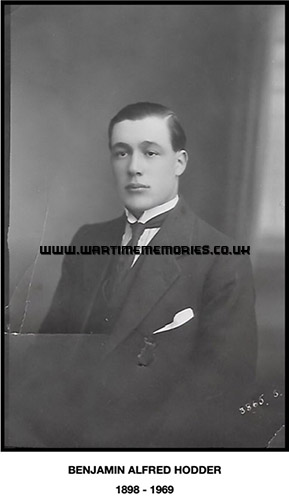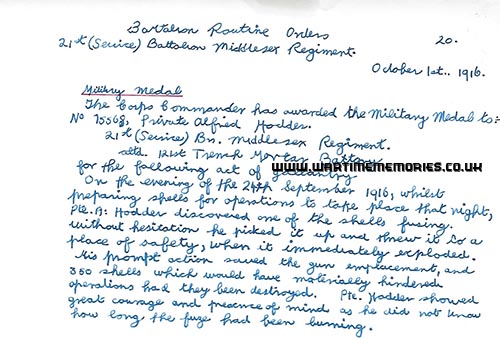Additions will be checked before being published on the website and where possible will be forwarded to the person who submitted the original entries. Your contact details will not be forwarded, but they can send a reply via this messaging system.
please scroll down to send a message
Cpl. Benjamin Alfred Hodder MM.
British Army 21st (Islington) Battalion Middlesex Regiment
from:Islington, London
Benjamin Hodder was my grandfather. In April 1915, at the age of sixteen years and four months, Ben enlisted in 6th Battalion Kings Royal Rifle Corps declaring his age as nineteen and his trade as an engineer. Family history has it that he ran away from school to join the Army. Like so many others at the time Ben had lied about his age and when this was discovered at Winchester, Hampshire after sixty-five days with the colours he was dismissed. Undeterred, seventeen days later he reenlisted at Islington into the 21st ˜Islington's Own Battalion, Middlesex Regiment using his middle name only probably because his time with KRRC was under the name Benjamin. At the outbreak of war in 1914, the British Army had 700,000 available men. Germany's army was over 3.7 million. In order to address this deficiency a campaign for volunteers was launched, thousands answered the call to fight and among them were 250,000 boys and young men under the age of 19, the legal limit for armed service overseas.
The 21st Middlesex was officially raised on the 18th May 1915 at Islington, London and was assigned to 121st Brigade, 40th Division in Kitchener's Army. Ben's commanding officers were Lieutenant Colonel W H Samuel and Majors J McCullough and S D Stewart. On 27th of May 1916 when at Woking, Surrey the 21st was ordered to France and on 5th of June Ben was one of almost a thousand officers and men who boarded trains to Southampton en route to France. The Battalion was split into two groups for the journey across the Channel with some boarding the Steamer Caesarea while others sailed on the Rossetti a former Argentine cattle ship. These two ships were often used to transport troops and had been doing so since 1914. I don't know which ship Ben was on but do know that the Caesarea arrived at Le Havre in the early hours of 6th of June and marched to a rest camp. Those that sailed on the Rossetti joined the others later that day before marching to billets at Barlin 150 miles to the north east towards the Belgium border.
Ben's two years on the Great War Western Front were spent in the area of British operations in north eastern France very close to the border with Belgium. He took part in most battles of the time subsequent to the infamous ˜First Day on the Somme and prior to his capture by Bavarian troops of the Imperial German Army during Ludendorffs Spring Offensive of 1918.
On 15th June 1916 Ben was detached from the 21st Middlesex and assigned to a newly formed Brigade asset, a Trench Mortar Battery. Trench mortars were a new innovation used in a variety of defensive and offensive roles. By mid 1916 most Divisions had Trench Mortar Batteries which took their number from the Brigade, so in Ben's case as part of 40th Division, 121st Brigade his battery was numbered 121st Trench Mortar Battery. The Battery was formed from Brigade units and put into billets at Lillers, 15 miles north east from Barlin. It consisted of two sections of two officers and NCOs and other ranks from each of the Brigade’s Regiments. Lt. Killinghack of 21st Middlesex Regiment was placed in overall command his fellow officers being Lt. Mansell 20th Middlesex, Lt. Jones 13th Yorkshire and 2nd/Lt. Barrett 12th Suffolk regiments.
As mentioned, Ben's unit arrived too late for the opening battle of the Somme on 1st July 1916 when 60,000 British soldiers were made casualties but moved into the line around Loos and was involved in fighting throughout the second half of 1916 through to April 1918. During this time he was awarded the Military Medal, would have pursued Germans toward the Hindenburg Line and fought in the battles of Fifteen Ravine, Villers Plouich, Beaucamp and La Vacquerie and the Cambrai Operations during which he was involved in operations to capture Bourlon Wood. He took part in the battles of St Quentin and Bapaume of the later Somme campaigns and was near to the fighting on the River Lys during Operation Georgette when he was taken prisoner.
20th June 1916 eight 3" Stokes Trench Mortars and six hand carts were received by the newly formed 121st Trench Mortar Battery. The guns were reportedly quite new and in excellent condition but the handcarts were very heavy and the officers complained that they would take a lot of pulling noting that at some stage horse transport would clearly be needed.
21st June 1916 Lt. Killinghack proceeded to Ferfey to the 1st Divisional Bomb School for a Trench Mortar course.
24th to 30th June 1916 three groups of 1 officer and ten other ranks went into Berbiers for their introductory training. The training took three days during which time they were billeted in town.
25th June 1916 the Battery received fifty 3" shells for practice and the next week began firing dummy shells and were put to work digging mortar emplacements.
3rd July 1916 the 121st Brigade moved to Les Brebis to relieve the 2nd Brigade and Ben and his colleagues busied themselves salvaging and making good mortar shells left behind, improving mortar emplacements and cleaning their dugouts. Sadly, the Battery was not issued with telephones which with weapons that are not line of sight I'd have considered essential. Lt. Killinghack clearly though so too and he, and a Captain Morris, the Brigade Scout Officer, went looking for potential observation points.
7th July 1916 Ben lost one of the Battery's officers who was reported to Brigade by Lt. Killinghack for displaying a lack of interest in his work. Lt. Jones was returned to his battalion and replaced by a 2nd Lt. Dowton. I don't know if Jones was Ben's commanding officer but I'm certain he would have been aware of the discipline issue.
8th July 1916 the battery attempted to destroy an enemy observation point but owing to the lack of telephones it proved difficult. They managed to hit it the following day, however, drawing retaliatory fire for two hours leading to a relocation of their mortar emplacements.
12th to 17th June 1916 Ben's Brigade was relieved by the 120th. This allowed time to clean up, engage in squad drills and practice firing with dummy shells away from the line. The battery was back at the front by the 17th and over the next five days engaged in firing and retaliation including on 21st July destroying German machine guns that had been firing at a Royal Flying Corps aeroplane.
23rd July 1916 the Battery moved to a different sector and when they had settled into their new surrounds the Germans sent over a welcome in the form of many trench mortars and rifle grenades. The following day the Battery was directed by Lt. Killinghack to move all eight of their mortars into the line and retaliate for the previous day's welcome.
20th August 1916 one of Ben's comrades Corporal Jones of the 12th Suffolk was killed and on the following day, Corporal Brown, also of the Suffolks was killed by heavy trench mortar which blew in the entrance of our dug-out and smashed in bomb recess and emplacement.
Sadly, the 121st TMB War Diary finishes on 31st August 1916 and the National Archive does not appear to have anything more from 121st Trench Mortar Battery which would include Ben's Military Medal action of 24th September 1916. Ben was preparing shells for forthcoming operations when he discovered a shell fusing. His swift action resulted in the award and citation.
Ben was captured on the 9th of April 1918 at the village of Fleurbaix near to the River Lys during ˜Operation Georgette. The German offensive was furious, and the British retreated. The situation was desperate and Field Marshall Douglas Haig, Commander of the British Expeditionary Force on the Western Front issued his famous ˜Backs to the Wall order, "There is no other course open to us but to fight it out! Every position must be held to the last man, there must be no retirement. With our backs to the wall and believing in the justice of our cause, each one of us must fight on to the end." The 121st Brigade had experienced horrendous casualties and at Doulieu, where stragglers were collected formed a composite Battalion and established a defensive line. The war continued until November but for Ben it was over. Captured at Fleurbaix he was transported to Germany to be held at Dulmen Prisoner of War Camp.

